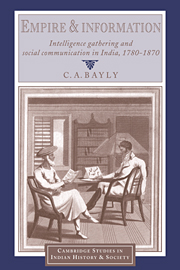Book contents
- Frontmatter
- Contents
- List of maps
- Preface
- Glossary
- List of abbreviations
- Introduction
- 1 Prologue: surveillance and communication in early modern India
- 2 Political intelligence and indigenous informants during the conquest of India, c. 1785–1815
- 3 Misinformation and failure on the fringes of empire
- 4 Between human intelligence and colonial knowledge
- 5 The Indian ecumene: an indigenous public sphere
- 6 Useful knowledge and godly society, c. 1830–50
- 7 Colonial controversies: astronomers and physicians
- 8 Colonial controversies: language and land
- 9 The information order, the Rebellion of 1857–9 and pacification
- 10 Epilogue: information, surveillance and the public arena after the Rebellion
- Conclusion: ‘Knowing the country’
- Bibliography
- Index
3 - Misinformation and failure on the fringes of empire
Published online by Cambridge University Press: 28 October 2009
- Frontmatter
- Contents
- List of maps
- Preface
- Glossary
- List of abbreviations
- Introduction
- 1 Prologue: surveillance and communication in early modern India
- 2 Political intelligence and indigenous informants during the conquest of India, c. 1785–1815
- 3 Misinformation and failure on the fringes of empire
- 4 Between human intelligence and colonial knowledge
- 5 The Indian ecumene: an indigenous public sphere
- 6 Useful knowledge and godly society, c. 1830–50
- 7 Colonial controversies: astronomers and physicians
- 8 Colonial controversies: language and land
- 9 The information order, the Rebellion of 1857–9 and pacification
- 10 Epilogue: information, surveillance and the public arena after the Rebellion
- Conclusion: ‘Knowing the country’
- Bibliography
- Index
Summary
The British were able to conquer the Indian subcontinent within a period of two generations because they commanded the Indian seas and the Bengal revenues. No less important, however, was the knowledge of the country that enabled the East India Company to use these resources to greatest effect. The subcontinent was straddled by complex and highly sophisticated information systems and the British had learned the art of listening in on these internal communications. By controlling newswriters, coralling groups of spies and runners, and placing agents at religious centres, in bazaars and among bands of military men and wanderers, they had been able to anticipate the coalitions of the Indian powers and to plot their enemies' movements and alliances. It was for this reason, rather than because of any deficiency of patriotism or absence of resistance, that there failed to materialise a general alliance against the British, an alliance of ‘all Puckery wallahs’ or turban-wearers against ‘all Topy wallahs’, or hat-wearers, as Tafazzul Hussain Khan put it.
As they moved beyond the intricate information systems of the Indian plains, the conquerors began to face unforeseen difficulties. In Nepal between 1814 and 1816, in Burma between 1824 and 1826, and on the northwestern frontiers through to the military debacle of 1838–42 and beyond, the British were often confronted by a virtual information famine which slowed their advance and sometimes put the whole edifice of their power in peril. Frontier wars these may have been, but the cumulative financial impact of military and intelligence failures undermined the Company's government.
- Type
- Chapter
- Information
- Empire and InformationIntelligence Gathering and Social Communication in India, 1780–1870, pp. 97 - 141Publisher: Cambridge University PressPrint publication year: 1997

